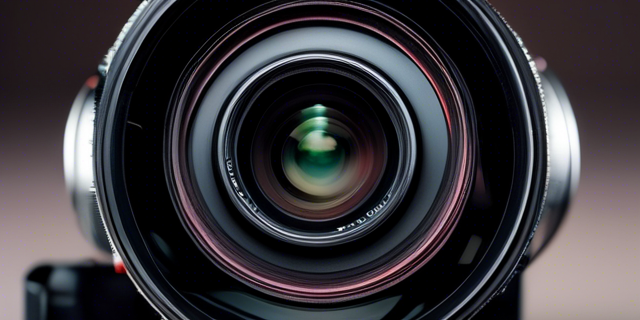Introduction to HD Camera Benefits
High-definition (HD) cameras have revolutionized the way we capture and view images and videos, offering unparalleled clarity and detail that enhance both personal and professional projects. Utilizing advanced technology, HD cameras can produce images with significantly higher resolution than standard-definition (SD) cameras. This leap in quality opens up a wide array of possibilities in photography and videography, making HD cameras a crucial tool for anyone aiming to produce visually engaging content. Whether it’s capturing a breathtaking landscape, a fast-paced sports event, or an intricate artistic performance, the benefits of HD cameras extend far beyond simple visual enhancements.
Advantages of HD Cameras
Enhanced Clarity
High-definition (HD) cameras are renowned for their superior clarity, setting them apart from standard-definition cameras. The higher pixel count in HD cameras means that each frame consists of millions of tiny pixels that produce a clearer and more detailed picture. This clarity is particularly beneficial in conditions where precision and detail are critical, such as in wildlife photography or capturing intricate patterns during an event. It allows photographers and videographers to capture images and videos that are not only beautiful but also true to life, ensuring that none of the subtle details are lost in translation from sight to screen.
Improved Detail
The detail captured by HD cameras is impeccable due to their high-resolution capabilities. Typical HD cameras operate at resolutions such as 1080p or even higher at 4K, offering several times more detail than standard definition cameras. This high level of detail is crucial for:
– Macro photography: where the intricate details of small subjects like insects or flora are captured.
– Event photography: where capturing the expressions and emotions of people in large gatherings is important.
– Landscape photography: which benefits from an expansive depth of field and sharpness across the entire image.
Photographers and videographers can utilize the improved detail to produce work that stands out in both artistic quality and technical excellence.
Quality of Images and Videos with HD Cameras
Crispness of Images
HD cameras deliver exceptionally crisp images, thanks to their high resolution. The crispness of the images produced is evident when viewing them on high-definition screens, where every pixel contributes to forming a complete, cohesive picture without blurring or undefined edges. This aspect is particularly beneficial for printing large-scale images or for use in high-quality publications where every detail must be visible and clear. Furthermore, crisp images are more engaging and can effectively communicate the photographer’s vision, making HD cameras ideal for professional portfolios and exhibits.
Richness of Colors
Color reproduction in HD cameras is another stand-out feature. These cameras typically support a wider color gamete and higher dynamic range, enabling them to capture colors more vividly and accurately than lower definition cameras. The richness of colors obtained with an HD camera adds a layer of realism and vibrancy to photographs and videos, making the final output more compelling. This is especially significant in fields like nature photography, where the accurate representation of the environment’s hues is essential, or in fashion photography, where the colors of fabrics need to be precisely rendered.
Smoothness of Video Footage
One of the most notable advantages of HD cameras in videography is the smoothness of the footage. Higher frame rates are common with HD video, often ranging from 60 frames per second and upwards, which significantly reduces motion blur and provides a fluid viewing experience. Smooth video is critical for:
– Sports and action scenes: where fast movements are common.
– Cinematic productions: where camera movements need to be seamless and visually pleasing.
– Documentaries: where stability in footage helps maintain focus on the subject matter.
Combined with features like image stabilization, HD cameras enable videographers to capture professional-grade footage suitable for various applications, from television broadcasting to online streaming, enhancing the audience’s viewing experience.
In conclusion, HD cameras provide a significant advantage for both professional and amateur photographers and videographers, thanks to their enhanced clarity, improved detail, and high-quality image and video outputs. These attributes make HD cameras a compelling choice for those aiming to produce visually stunning, high-quality works in photography and videography.
Versatility of HD Cameras
 Image courtesy: Unsplash
Image courtesy: Unsplash
The use of high-definition (HD) cameras spans numerous environments and purposes, showcasing their remarkable flexibility. Whether for personal use, professional photography, or videography, HD cameras offer a tool adaptable to many settings, making them a preferred choice for individuals and professionals alike.
Suitable for Various Settings
HD cameras thrive in a variety of physical environments and event types. Indoors, whether it’s capturing intimate dinner parties or large corporate events, the detailed resolution enhances the quality of the final image or footage, catching fine details that standard definition cameras might miss. Outdoors, and HD cameras perform exceptionally well, capturing landscapes with crisp clarity and vibrant colors that stand out in high-resolution displays. Sports events also benefit tremendously from HD technology, where fast-moving action can be frozen in time with sharp precision, allowing for detailed analysis and enjoyment. Moreover, in educational contexts, where detailed documentation and archival quality are paramount, HD cameras provide the requisite visual fidelity that can support effective learning and retention.
Adaptability to Different Lighting Conditions
One of the standout features of HD cameras is their ability to adapt to various lighting conditions. Modern HD cameras come equipped with advanced sensors that provide better performance in low-light environments compared to their standard-definition counterparts. This feature is particularly advantageous in scenarios like wildlife photography at dawn or dusk, or capturing scenes in dimly lit venues. HD cameras adjust their settings to optimize light intake without compromising the sharpness and clarity of the image. This adaptability not only enhances the quality of the images and videos taken but also expands the range of hours during which photographers and videographers can shoot high-quality content.
Professionalism and Credibility
 Image courtesy: Unsplash
Image courtesy: Unsplash
In the realm of professional media production, the clarity and detail offered by HD cameras contribute significantly to the perceived professionalism and credibility of the content creator. This impact is evident across various forms of media — from news broadcasting to cinematic production, where the demand for high-quality visual content continues to rise.
Impact on Professional Work
For professionals in the fields of photography and videography, upgrading to an HD camera can dramatically elevate the quality of their work. This improvement directly affects their portfolio attractiveness and can lead to better client engagements and higher rates. For example, wedding photographers using HD cameras can offer clients vivid photos and videos that make their special day unforgettable. Similarly, wildlife photographers benefit from the enhanced zoom capabilities and higher resolution, which allow for breathtaking close-up shots with exquisite detail. Furthermore, in the film industry, the use of HD cameras is essential not just for shooting main sequences but also for creating high-quality trailers and behind-the-scenes footage that generate interest and buzz.
Perception in the Industry
The adoption of HD cameras is often seen as a hallmark of professionalism within the multimedia industry. Professionals who utilize HD technology are typically regarded as more committed to their craft and more attentive to the quality and technical aspects of their outputs. This perception not only enhances their reputation but also sets a standard in the industry, pushing the envelope for what is considered acceptable quality of visual content. Clients and audiences increasingly expect high-definition quality, and professionals equipped with the right technology are seen as better positioned to deliver on these expectations. Moreover, the use of HD cameras can often be a deciding factor in winning contracts, as clients may prefer providers who can deliver the highest quality visuals possible.
In conclusion, HD cameras represent a fusion of versatility, professionalism, and adaptability, making them indispensable tools in the arsenal of anyone involved in capturing images or videos. Their ability to produce outstanding quality content in a variety of settings and conditions not only enhances the visual experience but also contributes to higher standards and expectations in the photography and videography industries.
Technical Aspects of HD Cameras
HD cameras, an essential tool in modern photography and videography, offer a myriad of technical benefits that are crucial for producing high-quality content. These technical aspects include resolution, frame rates, and lens quality, each contributing to the overall performance and output of the cameras.
Resolution and Pixels
Resolution refers to the number of pixels that make up the image on a display, expressed in terms of the width and height of the image. HD cameras typically offer resolutions such as 720p (1280×720 pixels), 1080p (1920×1080 pixels), and even 4K (3840×2160 pixels), providing much sharper and more detailed images than standard definition cameras. The higher the resolution, the more pixels there are, which means finer details can be captured. This is particularly important in professional settings where clarity and detail are paramount, such as in wildlife photography or high-paced sports where every detail counts.
Frame Rates
The frame rate of a camera, measured in frames per second (fps), defines how many images the camera can capture within one second. Standard frame rates include 24fps, 30fps, and 60fps, with higher frame rates such as 120fps or even 240fps used for slow-motion effects. A higher frame rate is essential for capturing smoother video and is particularly useful in videography where motion is heavily involved. For instance, sports videographers benefit from higher frame rates to capture quick movements clearly and smoothly, reducing motion blur and ensuring that every action is crisply recorded.
Lens Quality
The quality of the lens is another crucial aspect of HD cameras that affects the clarity and quality of the captured image. High-definition cameras often come with advanced lens options, featuring multiple elements and special coatings to reduce aberrations and enhance optical performance. The lens quality also impacts the camera’s depth of field, allowing for stunning portraits with blurred backgrounds or sharp landscapes that maintain focus throughout the entire scene. Good lenses also perform better in low light conditions, capturing clear images even when lighting is not ideal.
Expanding Creative Possibilities
 Image courtesy: Unsplash
Image courtesy: Unsplash
The advanced capabilities of HD cameras not only enhance technical performance but also open up new avenues for creativity and innovative projects. Photographers and videographers can expand their artistic expression and explore new project ideas with the enhanced features offered by these cameras.
Artistic Expression
HD cameras empower photographers and videographers to push the boundaries of their creative visions. High resolution and excellent image quality allow for intricate detail in every shot, capturing textures and colors more vividly. This level of detail is essential for artistic photography, where the expression of fine details can make a significant difference in the impact of the image. Moreover, the ability to shoot in high frame rates enables creatives to experiment with time-lapse and slow-motion videography, techniques that can transform mundane scenes into stunning visuals. The enhanced depth of field provided by quality lenses allows artists to play with focus, creating images that draw the viewer’s eye to specific areas in a way that was not possible with lower-definition equipment.
Innovation in Projects
The advent of HD technology has sparked a revolution in how projects are conceptualized and delivered. Filmmakers now have at their disposal tools that can capture cinema-quality footage, making independent projects more competitive against those with larger budgets. In the realm of marketing and advertising, the clarity and preciseness of HD visuals contribute to creating more engaging and persuasive content. For educators and content creators, HD cameras offer the ability to produce clear educational materials that can hold the viewer’s attention longer and convey information more effectively. Additionally, the integration of HD cameras with drones and other novel filming equipment opens up possibilities for capturing footage from inventive angles and vantage points, thereby refreshing traditional perspectives and giving life to groundbreaking project ideas.
In conclusion, the superior technical features of HD cameras not only enhance the quality of the images and videos but also expand the possibilities for creative and innovative projects.
Conclusion – Embracing the Advantages of HD Cameras
In the digital age, where visual content dominates our communication and media, HD cameras play a pivotal role. By embracing the multitude of benefits offered by high-definition technology, from unparalleled clarity and impressive color accuracy to enhanced low-light performance and high frame rates, both novices and professionals can achieve stellar photographic and videographic outcomes. Investing in an HD camera is not merely about capturing images and videos, but about preserving memories, emotions, and moments in utmost clarity. Whether it’s for personal use, professional assignments, or merely to embrace the hobby of photography and videography, an HD camera stands as a wise and essential gadget in the modern era.
Understanding and utilizing the full spectrum of features provided by HD cameras will undoubtedly enrich the quality of your visual projects and provide you with tools to bring your creative visions to life.






